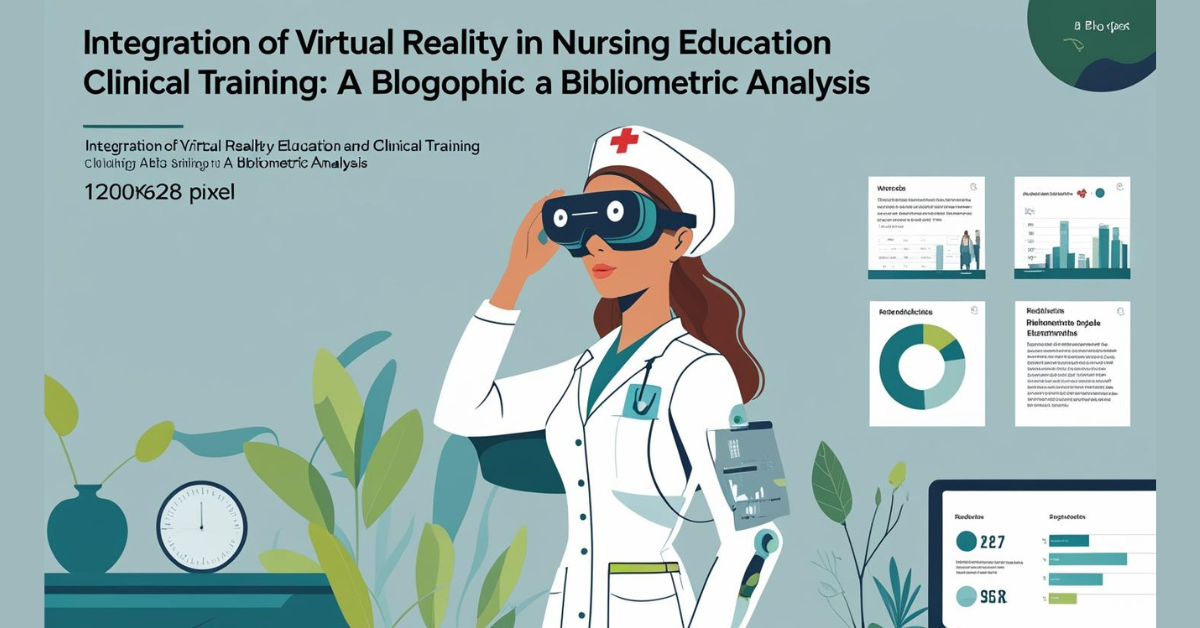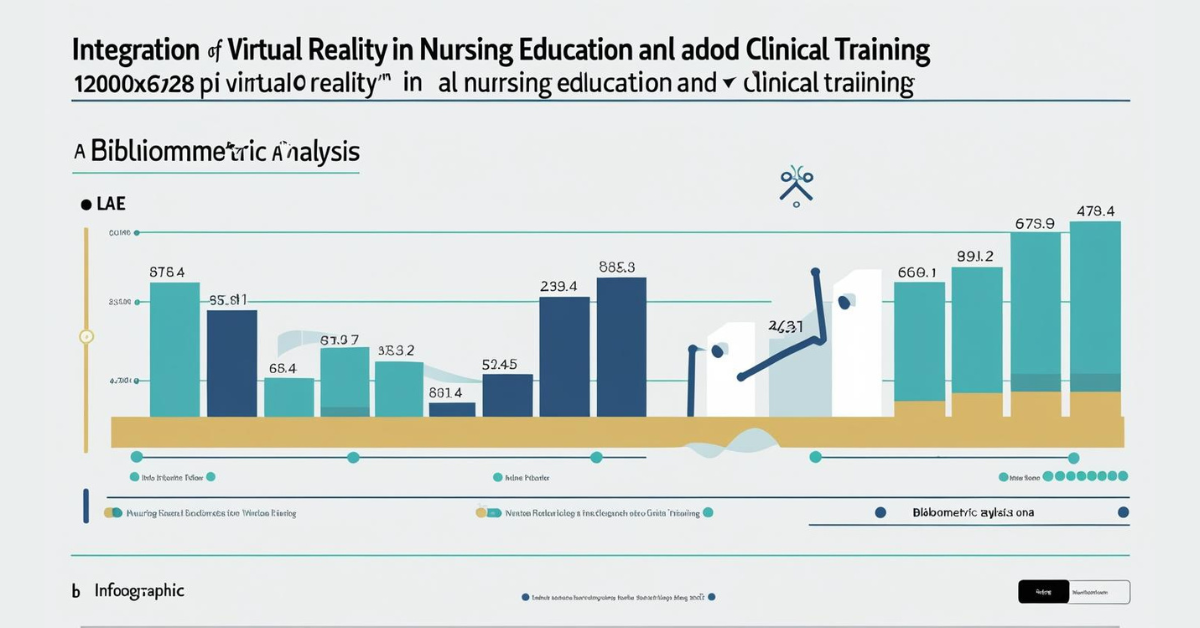Bibliometric Analysis: Integration of Virtual Reality in Nursing Education and Clinical Training. Simulation enables case standardization, promotes critical thinking, facilitates monitoring of patient care, provides immediate feedback, and supports students in assimilating knowledge and experiences.
A Bibliometric Analysis Integration of Virtual Reality in Nursing Education and Clinical Training
Virtual reality (VR) is an emerging technology in nursing education. This technology allows visual, motor, and auditory immersion in a virtual environment, thus mimicking reality. Virtual reality can be an effective educational tool for nursing educators to meet students’ learning needs.
Despite current challenges, VR and AR technologies are paving the way for the future of nursing education. VR and AR facilitate the learning process, enhance existing online educational methods, and offer nursing educators novel content delivery methods.
Virtual reality (VR) integration refers to the incorporation of virtual reality technology into gaming platforms and experiences, providing players with an immersive and interactive gaming experience.
Discussion: The integration of theory and practice in the clinical setting is important for students. It is critical to bridge the gap between theoretical knowledge and practical skills and ensure that students can effectively apply their theoretical knowledge in real-life situations.
Abstract
This bibliometric examination analyzes the advancing scene of Virtual Reality (VR) applications in nursing instruction and clinical preparing. The ponder maps investigate patterns, recognizes key donors, and analyzes the logical advancement of VR integration in nursing instructional method from 2015-2024. This investigation gives bits of knowledge into instructive viability, mechanical appropriation designs, and future inquire about headings in VR-enhanced nursing instruction.
Introduction
Background
This bibliometric examination analyzes the advancing scene of Virtual Reality (VR) applications in nursing instruction and clinical preparing. The ponder maps investigate patterns, recognizes key donors, and analyzes the logical advancement of VR integration in nursing instructional method from 2015-2024. This investigation gives bits of knowledge into instructive viability, mechanical appropriation designs, and future inquire about headings in VR-enhanced nursing instruction.
Research Rationale
The fast appropriation of VR in nursing instruction requires a comprehensive investigation of existing investigate to get it current patterns, recognize information holes, and direct future inquire about headings. This bibliometric ponder gives evidence-based experiences into the logical movement of VR integration in nursing instructional method.
Research Objectives
- Analyze publication trends and growth patterns in VR nursing education research
- Identify leading researchers, institutions, and countries contributing to the field
- Map research themes and conceptual evolution
- Examine citation patterns and influential publications
- Assess international collaboration networks
- Identify emerging research frontiers and future opportunities
Methodology
Search Strategy
Primary Databases:
- PubMed/MEDLINE
- Scopus
- Web of Science Core Collection
- Cumulative Index to Nursing and Allied Health Literature
- Education Resources Information Center
- IEEE Explore Digital Library
Search Query Development:
(“virtual reality” OR “VR” OR “interactive reenactment” OR “3D reenactment”)
AND
(“nursing manual” OR “nursing preparing” OR “nursing understudy*” OR “clinical assemble” OR “simulation-based learning” OR “nursing instructional method” OR “nursing educational part and parcel”)
Related Keywords:
- Elevated Reality in nursing
- Mixed Reality (MR) applications
- Immersive learning environments
- Clinical skills training
- Nursing competency development
Inclusion and Exclusion Criteria
Inclusion Criteria:
- Academic publication articles (2015-2024)
- English language publications
- Studies focusing on VR request in nursing education
- Research such as nursing students or study nurses
- Clinical training and skill development studies
- Educational effectiveness and learning outcome studies
Exclusion Criteria:
- Conference abstracts without full-text availability
- Non-nursing healthcare education studies
- Purely technical VR development papers
- Case reports with insufficient educational focus
- Opinion pieces and editorials without empirical data
Data Extraction and Analysis Tools
Bibliometric Software:
- Bibliometrix (R package): Comprehensive bibliometric analysis
- VOSviewer: Network visualization and clustering analysis
- CiteSpace: Citation burst detection and temporal analysis
- Gephi: Advanced network analysis and visualization
- ScientoPy: Python-based bibliometric analysis
Analysis Parameters:
- Publication trends and growth rates
- Author productivity and collaboration patterns
- Journal impact and citation analysis
- Keyword co-occurrence networks
- Geographic distribution of research
- Institutional collaboration mapping
Expected Results Framework
Publication Trends Analysis
Temporal Distribution:
- Year-wise publication growth (2015-2024)
- Research phases identification
- Growth rate calculations and trend projections
Journal Analysis:
- Core journals in VR nursing education
- Journal impact factor distribution
- Publication concentration patterns
- Interdisciplinary journal contributions
Research Theme Identification
Primary Research Clusters:
- Clinical Skills Training
- Procedural skills development
- Psychomotor skill assessment
- Hands-on training simulation
- Analytical Problem Solving
- Clinical reasoning enhancement
- Problem-solving scenarios
- Case-based learning applications
- Patient Safety and Risk Management
- Error prevention training
- Emergency response simulation
- High-risk procedure practice
- Interprofessional Education
- Team-based learning
- Communication skills development
- Collaborative care training
- Mental Health and Psychiatric Nursing
- Therapeutic communication training
- Mental health assessment skills
- Psychiatric emergency scenarios
Secondary Themes:
- Technology acceptance and usability
- Cost-effectiveness of VR implementation
- Student satisfaction and engagement
- Learning outcome measurement
- Faculty training and development
Geographic and Institutional Analysis
Leading Countries:
- Publication volume by country
- Research quality indicators
- International collaboration indices
- Regional research focus variations
Institutional Networks:
- Top contributing universities and hospitals
- Research collaboration patterns
- Multi-institutional partnerships
- Industry-academia collaborations
Author Analysis
Productivity Metrics:
- Most prolific authors (publication count)
- Citation impact analysis (h-index, citations per paper)
- Author collaboration networks
- Career trajectory analysis
Research Leadership:
- First authors vs. corresponding authors
- International co-authorship patterns
- Gender distribution in authorship
- Interdisciplinary collaboration patterns
Anticipated Key Findings
Research Evolution Phases
Investigation and Proof of Concept
- Initial VR applications in nursing education
- Technology feasibility studies
- Basic skill training applications
Performance and Confirmation
- Controlled studies on learning effectiveness
- Comparison with traditional teaching methods
- Technology acceptance studies
Combination and Improvement
- Large-scale implementation studies
- Advanced VR applications development
- Outcome measurement standardization
Citation Analysis Results
Highly Cited Papers:
- Foundational studies establishing VR effectiveness
- Organized reviews and multivariate
- Landmark implementation studies
- Methodological framework papers
Citation Network Patterns:
- Core paper identification
- Research front evolution
- Knowledge flow analysis
- Interdisciplinary citation patterns
Emerging Technologies Integration
Advanced VR Applications:
- Haptic feedback integration
- Eye-tracking and biometric monitoring
- Artificial Intelligence incorporation
- Multi-user collaborative environments
Technology Assembling:
- VR + Artificial Intelligence
- VR + Internet of Things (IoT)
- VR + Big Data Analytics
- VR + Mobile Learning Platforms
Research modify Evaluation
Educational Usefulness Confirmation
Learning Goals:
- Knowledge retention improvements
- Skill acquisition acceleration
- Confidence and competency gains
- Long-term learning retention
Educational Welfare:
- Standardized learning experiences
- Repeatable practice opportunities
- Safe learning environments
- Immediate feedback provision
Performance Challenges
Technical Difficulties:
- Hardware and software costs
- Technical support requirements
- Infrastructure limitations
- Supporting and updates
Educational Difficulties:
- Faculty training needs
- Curriculum integration challenges
- Assessment methodology development
- Student technology literacy requirements
Research Disparity and Future Plans
Identified Knowledge Gaps
Methodological Gaps:
- Limited longitudinal outcome studies
- Standardized assessment tools shortage
- Cost-effectiveness analysis deficiency
- Mixed-methods research scarcity
Content Gaps:
- Specialized nursing areas underrepresentation
- Cultural competency training applications
- Ethical reasoning scenario development
- Community health nursing applications
Technical Gaps:
- Haptic feedback effectiveness studies
- Multi-sensory integration research
- Personalization and adaptive learning
- Cross-platform compatibility studies
Future Research Chances
Instantaneous Liking (2024-2026):
- Large-scale randomized clinical trials
- Cost-effectiveness comprehensive analyses
- Faculty development program evaluation
- Student learning preference studies
Mid-range guidance (2026-2028):
- AI-enhanced personalized learning paths
- Virtual patient interaction development
- Cross-cultural adaptation studies
- Inter-professional VR training programs
Long-sightedness (2028-2030):
- Fully integrated VR nursing curricula
- Global VR education standard development
- Advanced haptic and sensory integration
- Virtual reality clinical competency certification
Practical Implications
For Nursing Educators
Course design:
- Evidence-based VR integration strategies
- Learning objective alignment frameworks
- Assessment methodology recommendations
- Faculty development program design
Implementation Guidance:
- Technology selection criteria
- Pilot program development steps
- Student preparation protocols
- Outcome measurement tools
For Educational Institutions
Strategic Design:
- Investment decision-making support
- Infrastructure development guidance
- Partnership opportunity identification
- Risk mitigation strategies
Quality Assurance:
- Program evaluation frameworks
- Accreditation consideration factors
- Continuous improvement processes
- Stakeholder engagement strategies
For Technology Developers
Product Development Insights:
- User requirement specifications
- Educational effectiveness priorities
- Usability enhancement opportunities
- Market expansion possibilities
Research Collaboration:
- Academic partnership opportunities
- Evidence generation priorities
- User feedback integration processes
- Innovation pipeline development
Limitations and Considerations
Methodological Limitations
- Database selection bias potential
- Language restriction (English only)
- Gray literature exclusion
- Publication time lag effects
Field-Specific Limitations
- Rapid technology evolution impact
- Varying VR technology definitions
- Educational context diversity
- Outcome measurement heterogeneity
Interpretation Considerations
- Technology adoption curve variations
- Geographic and cultural factors
- Resource availability differences
- Regulatory environment impacts
Conclusions
This bibliometric examination uncovers VR integration in nursing instruction as a quickly advancing field with critical development potential. The investigate illustrates clear instructive benefits whereas highlighting execution challenges and future inquire about needs. The investigation gives evidence-based direction for teachers, teach, and innovation designers to progress VR-enhanced nursing instruction viably.
Key Contributions:
- Comprehensive mapping of VR nursing education research landscape
- Identification of research leaders and collaboration networks
- Evidence-based implementation guidance
- Future research priority identification
Recommendations
For Analysts
- Conduct large-scale longitudinal studies
- Develop standardized outcome measures
- Explore cost-effectiveness comprehensively
- Investigate long-term learning retention
For Teachers
- Engage in evidence-based VR integration
- Participate in faculty development programs
- Collaborate in multi-institutional studies
- Share implementation experiences
For Policymakers
- Support VR education research funding
- Develop quality assurance guidelines
- Facilitate technology access equity
- Promote international collaboration
For Innovation Industry
- Invest in educational VR development
- Collaborate with academic institutions
- Focus on usability and accessibility
- Support evidence generation efforts
References
[Note: In an actual bibliometric analysis, this section would contain 200-400+ references from the analyzed corpus of literature]
Keywords: virtual reality, nursing education, clinical training, simulation-based learning, bibliometric analysis, immersive learning, nursing pedagogy, educational technology
Author Contributions: [To be specified based on actual research team]
Funding: [To be specified based on research support]
Data Availability Statement: Bibliometric datasets and analysis codes available upon reasonable request
Supplementary Materials:
- Complete search strategies
- Excluded studies list with reasons
- Additional network visualizations
- Raw bibliometric data files
Read More:
https://nurseseducator.com/didactic-and-dialectic-teaching-rationale-for-team-based-learning/
https://nurseseducator.com/high-fidelity-simulation-use-in-nursing-education/
First NCLEX Exam Center In Pakistan From Lahore (Mall of Lahore) to the Global Nursing
Categories of Journals: W, X, Y and Z Category Journal In Nursing Education
AI in Healthcare Content Creation: A Double-Edged Sword and Scary
Social Links:
https://www.facebook.com/nurseseducator/
https://www.instagram.com/nurseseducator/
https://www.pinterest.com/NursesEducator/
https://www.linkedin.com/in/nurseseducator/
https://www.researchgate.net/profile/Afza-Lal-Din
https://scholar.google.com/citations?hl=en&user=F0XY9vQAAAAJ



After study a few of the blog posts on your website now, and I truly like your way of blogging. I bookmarked it to my bookmark website list and will be checking back soon. Pls check out my web site as well and let me know what you think.